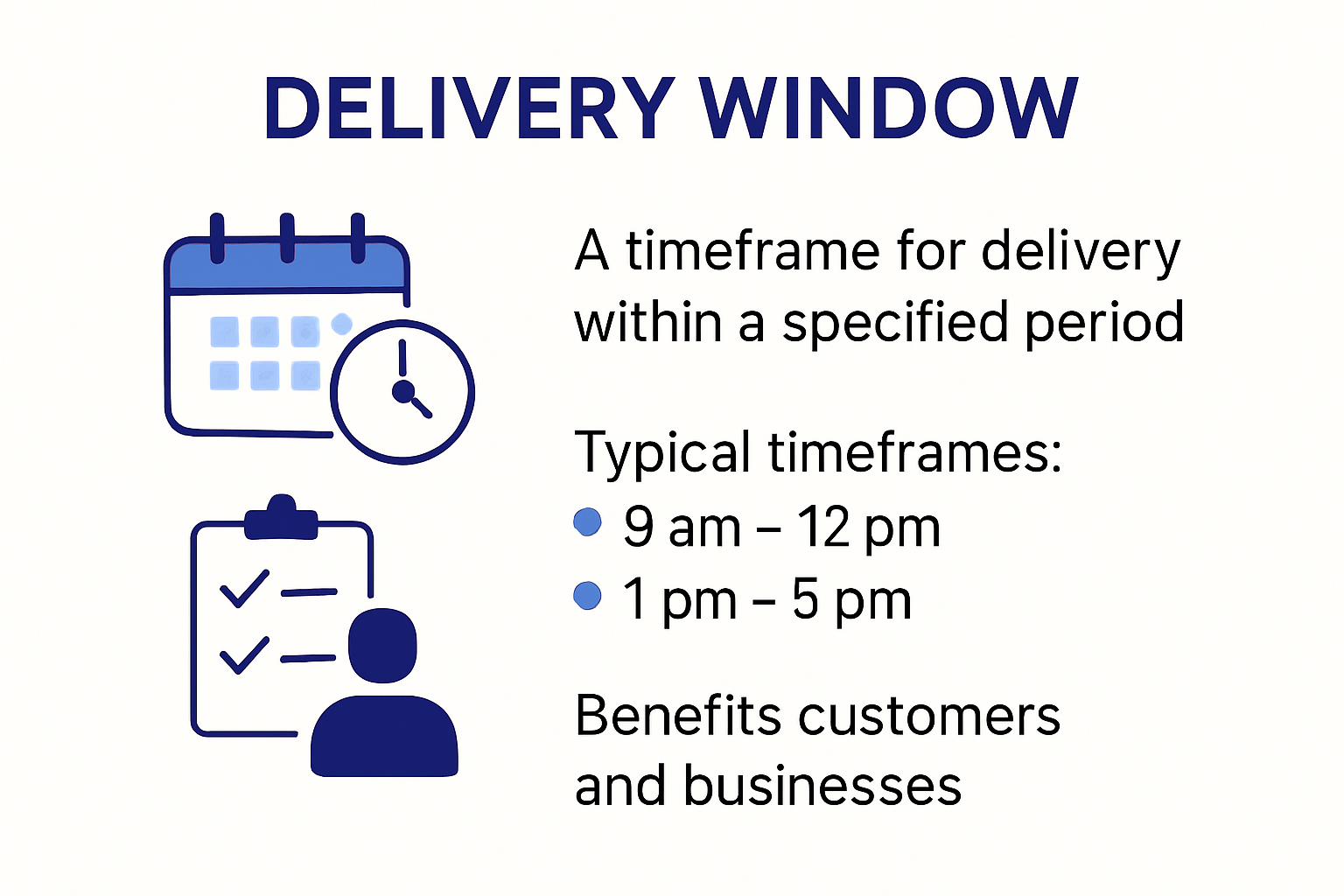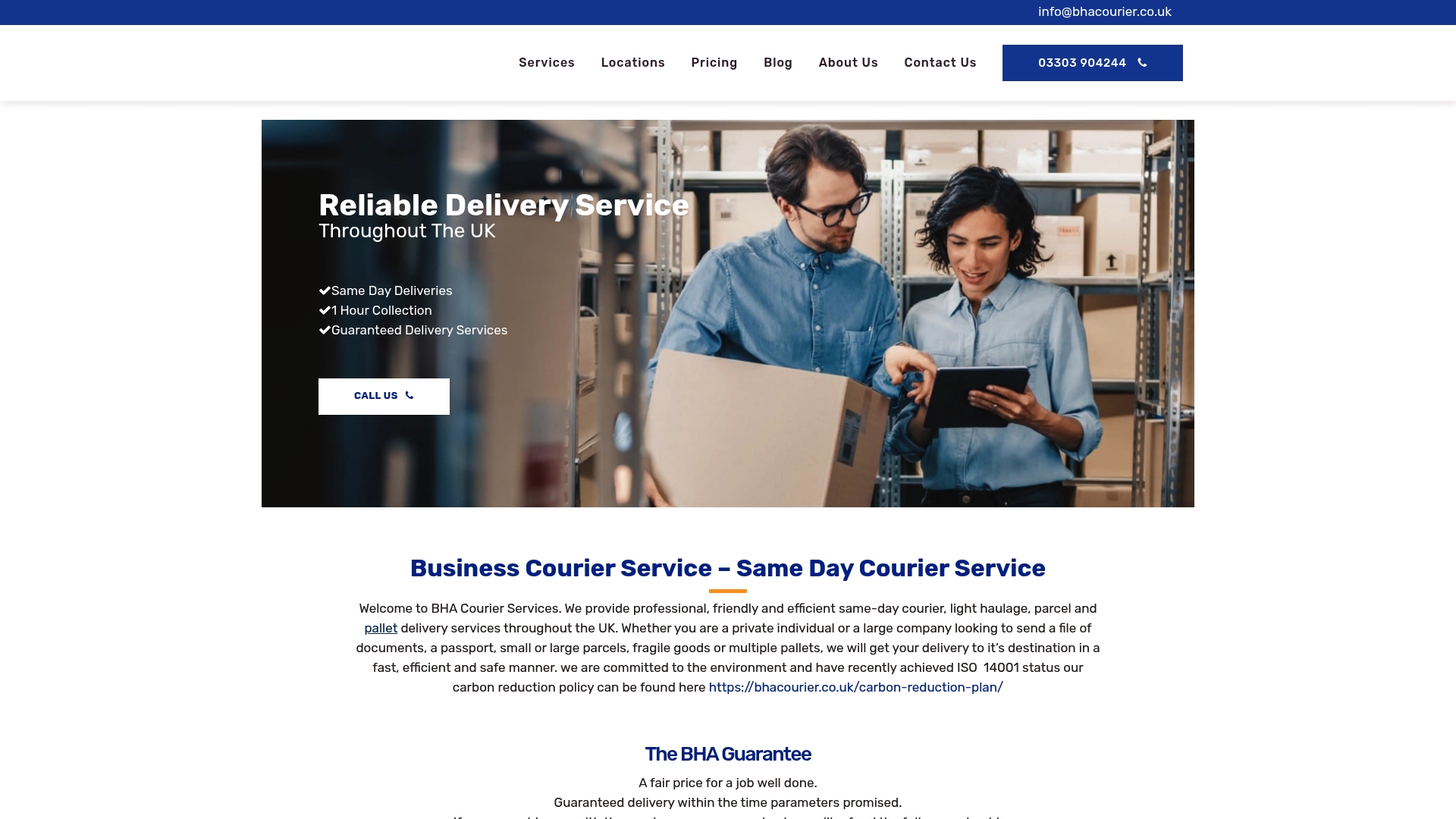
12 Jul What Is Delivery Window? Guide for UK Businesses 2025

Every time you order a parcel online, there’s a window of time when you expect it to arrive at your door. Sounds straightforward, right? Yet, 95 percent of UK businesses now see express parcel services as vital to their operations, turning these delivery windows into a powerful business lever rather than just a box-ticking exercise. Here’s the surprising part: nailing the delivery window doesn’t just please customers, it can mean the difference between thriving or being left behind in the UK’s fast-paced market.
Table of Contents
- Understanding What Is Delivery Window
- Why Delivery Windows Matter For Businesses
- How To Set Accurate Delivery Windows
- Best Practices For Managing Delivery Windows
Quick Summary
| Takeaway | Explanation |
|---|---|
| Importance of Delivery Windows | Delivery windows are essential for managing customer expectations, optimising efficiency, and minimising uncertainties in the logistics process. |
| Economic Benefits | Efficient delivery windows enhance customer retention, operational efficiency, and cost management, thus giving businesses a competitive edge. |
| Customer-Centric Approach | Allowing customers to choose their delivery slots and providing real-time updates can significantly reduce failed delivery attempts and increase satisfaction. |
| Technology Integration | Leveraging technology such as GPS tracking and predictive analytics is crucial in creating reliable and accurate delivery windows. |
| Continuous Improvement | Regular performance monitoring, standardized processes, and quality management reviews are vital for adapting to challenges and enhancing delivery efficiency. |
Understanding What Is Delivery Window
A delivery window represents a precise timeframe designated for receiving a package or shipment, serving as a critical component in modern logistics and customer service strategies. This concept goes beyond simple delivery timing, offering businesses and consumers a structured approach to managing expectations and ensuring efficient transportation of goods.

Defining the Delivery Window Concept
At its core, a delivery window is a specified period during which a package is expected to arrive at its destination. Unlike traditional delivery methods that provided vague timeframes, modern delivery windows offer increased precision and transparency. The Department for Transport highlights the significance of these windows in managing “last mile” logistics, which represents the final stage of goods movement from transportation hubs to ultimate delivery points.
Delivery windows typically range from narrow two-hour slots to broader four to six-hour periods, depending on the service provider and specific logistical requirements. For businesses, these windows are not just about timing but also about managing customer expectations, optimising route efficiency, and minimising delivery-related uncertainties.
Key Components of an Effective Delivery Window
Successful delivery windows incorporate several critical elements that ensure reliability and customer satisfaction. The NHS Supply Chain demonstrates how organisations can implement structured delivery approaches across various contexts.
Key components include:
- Precise Timing: Clearly defined start and end times for potential delivery
- Flexibility: Accommodating potential logistical challenges
- Communication: Providing real-time updates about delivery status
- Tracking Capabilities: Enabling customers to monitor their shipment
Here is a table summarising the key components of an effective delivery window and their description:
| Component | Description |
|---|---|
| Precise Timing | Clearly defined start and end times for delivery |
| Flexibility | Ability to accommodate logistical challenges |
| Communication | Providing real-time updates about delivery status |
| Tracking Capabilities | Allowing customers to monitor shipment in real-time |
Technology and Delivery Window Precision
Modern technological solutions have revolutionised delivery window management. Advanced GPS tracking, route optimization algorithms, and real-time communication platforms enable businesses to provide increasingly accurate delivery estimates. NHS Wales Shared Services Partnership exemplifies how diverse organizations can leverage technology to manage complex delivery requirements across different vehicle sizes and specifications.
For businesses, implementing robust delivery window strategies means balancing customer convenience with operational efficiency. This involves understanding local traffic patterns, potential logistical interruptions, and maintaining a flexible approach that can adapt to unexpected challenges.
Whether you are an e-commerce retailer, a healthcare supplier, or a local service provider, understanding and implementing effective delivery windows can significantly enhance customer satisfaction and operational performance. The key lies in combining technological precision with customer-centric approaches that prioritize transparency and reliability.
Why Delivery Windows Matter for Businesses

In the dynamic landscape of modern commerce, delivery windows have transformed from a mere logistical detail to a strategic business imperative. As consumer expectations continue to evolve, businesses must recognize the profound impact that precise and reliable delivery windows can have on their operational success and customer satisfaction.
Economic and Competitive Advantages
According to the Confederation of British Industry, an astounding 95% of UK businesses consider express parcel services vital to their operations. This statistic underscores the critical role that efficient delivery windows play in maintaining competitive edge. When businesses can consistently meet or exceed delivery expectations, they differentiate themselves in a crowded marketplace.
Delivery windows directly influence several key business metrics:
- Customer Retention: Predictable delivery times build trust and encourage repeat business
- Operational Efficiency: Structured delivery slots optimize route planning and resource allocation
- Cost Management: Precise windows reduce unnecessary waiting times and potential redelivery expenses
Customer Experience and Satisfaction
The Scottish Government’s review revealed that 93% of online shoppers were satisfied with their last delivery, highlighting the direct correlation between delivery performance and customer perception. Modern consumers do not just want products they want a seamless, transparent delivery experience.
Businesses that implement robust delivery windows can expect:
- Enhanced customer communication
- Reduced anxiety about delivery uncertainties
- Increased likelihood of positive reviews and recommendations
Logistical Optimization and Urban Efficiency
Transport for London reports that managing delivery times effectively can reduce journey times by up to 18.5%, demonstrating the broader urban and environmental benefits of strategic delivery windows.
By adopting sophisticated delivery window strategies, businesses can:
- Minimize traffic congestion
- Reduce carbon emissions
- Improve overall urban mobility
- Create more predictable and sustainable transportation networks
Delivery windows are no longer a peripheral concern but a central component of business strategy. They represent a critical intersection of customer service, operational efficiency, and technological innovation. For businesses looking to thrive in an increasingly competitive and consumer-driven market, mastering the art of precise, reliable delivery windows is not just an option it is a necessity.
How to Set Accurate Delivery Windows
Setting accurate delivery windows requires a strategic approach that combines technological insights, customer preferences, and operational capabilities. Businesses must develop a comprehensive methodology to ensure reliability, efficiency, and customer satisfaction.
Data-Driven Delivery Window Planning
Number Analytics emphasizes the critical role of data analytics in establishing precise delivery windows. By utilizing predictive modeling and historical performance data, businesses can create more realistic and dependable delivery estimates.
Key data points for accurate planning include:
- Historical delivery performance metrics
- Traffic pattern analysis
- Geographic route complexity
- Seasonal variations in delivery conditions
Businesses can leverage advanced algorithms to predict potential delays and create buffer times that accommodate unexpected challenges while maintaining customer expectations.
Flexible Time Slot Strategies
Deliverect recommends implementing flexible two-hour or four-hour delivery windows to optimize route efficiency and distribute delivery demand more evenly. This approach allows businesses to:
- Reduce peak-time congestion
- Minimize transportation costs
- Provide customers with more convenient options
- Increase overall delivery reliability
Customer-Centric Delivery Window Selection
Research from European Transport Research Review demonstrates that offering customers the ability to select preferred delivery times can significantly reduce failed delivery attempts. This customer-driven approach involves:
- Providing multiple time slot options
- Allowing real-time slot modifications
- Sending proactive communication about potential changes
- Offering precision tracking capabilities
Successful delivery window implementation requires a holistic approach that balances technological capabilities, operational constraints, and customer preferences. By combining data-driven insights with flexible strategies, businesses can create delivery windows that enhance customer satisfaction while maintaining operational efficiency.
Ultimately, the most effective delivery windows are those that provide transparency, flexibility, and reliability. Continuous refinement based on performance data and customer feedback remains essential in adapting to evolving logistical challenges and consumer expectations.
Best Practices for Managing Delivery Windows
Managing delivery windows effectively requires a strategic approach that combines technological innovation, operational excellence, and customer-centric methodologies. Businesses must develop robust systems that ensure consistent performance and adaptability in an increasingly complex logistics landscape.
Operational Performance and Continuous Improvement
According to NHS Digital’s Cloud Development Guidance, implementing standardized processes is crucial for enhancing delivery efficiency. This approach involves creating consistent operational frameworks that reduce variability and improve overall performance.
Key strategies for operational management include:
- Regular Performance Monitoring: Tracking delivery metrics and identifying improvement opportunities
- Standardized Protocols: Developing uniform procedures across delivery teams
- Continuous Training: Ensuring staff are updated on latest delivery technologies and methodologies
Below is a table outlining key operational strategies and their purpose in managing delivery windows:
| Strategy | Purpose |
|---|---|
| Regular Performance Monitoring | Identify improvement opportunities in delivery metrics |
| Standardized Protocols | Ensure consistency and efficiency across delivery teams |
| Continuous Training | Equip staff with up-to-date knowledge on delivery processes |
Quality Management and Strategic Review
The UK Government’s Digital Delivery Guidelines recommend establishing quarterly business reviews to assess operational performance. This systematic approach allows organizations to:
- Identify performance trends
- Share best practices across departments
- Develop targeted improvement strategies
- Maintain high levels of operational excellence
Technology and Process Integration
NHS England’s Continuous Improvement Review emphasizes the importance of embedding quality management systems that coordinate assurance, improvement, and planning activities.
Effective technology integration involves:
- Advanced Tracking Systems: Real-time monitoring of delivery progress
- Predictive Analytics: Forecasting potential delivery challenges
- Automated Communication Platforms: Keeping customers informed about delivery status
- Flexible Routing Algorithms: Optimizing delivery paths in real-time
Successful delivery window management is not a static process but a dynamic approach that requires constant refinement. Businesses must remain agile, leveraging technological innovations and data-driven insights to meet evolving customer expectations.
The most effective organizations view delivery windows not as a logistical challenge but as a strategic opportunity to differentiate themselves in a competitive marketplace. By combining technological sophistication with customer-centric approaches, businesses can transform delivery windows from a operational necessity into a significant competitive advantage.
Frequently Asked Questions
What is a delivery window?
A delivery window is a specified timeframe during which a package is expected to arrive at its destination, helping manage customer expectations and optimise logistics.
Why are delivery windows important for businesses?
Delivery windows are crucial as they enhance customer satisfaction, improve operational efficiency, and provide a competitive edge in the marketplace by ensuring predictable delivery times.
How can businesses set accurate delivery windows?
Businesses can set accurate delivery windows by utilising data-driven planning, offering flexible time slots, and adopting a customer-centric approach to meet consumer preferences.
What are the best practices for managing delivery windows?
Best practices include regular performance monitoring, standardising operational protocols, integrating technology for tracking and communication, and continuously reviewing and improving delivery processes.
Want Absolute Control Over Your Delivery Windows?
Are you feeling the pressure from unpredictable delivery slots or struggling to meet customer demands for precise, reliable delivery times? Your business cannot afford failed deliveries and missed expectations, especially when every minute counts and customer loyalty is at stake. The guide you have just read makes it clear: mastering delivery windows depends on seamless execution, real-time alerts, and the security only specialists can offer.

Turn your delivery commitments into a real competitive advantage. With BHA Courier’s rapid and secure services, you receive guaranteed timeframes, live tracking, and nationwide coverage for everything from urgent documents to delicate parcels. Book with confidence and ensure your customers are never left waiting — visit https://bhacourier.co.uk now and experience hassle-free, dependable delivery that keeps your business moving forward.
Recommended
- BHA Couriers BHA Couriers Blog – Same Day Delivery Across The UK
- BHA Couriers East Midlands | Dedicated Delivery
- What Insurance Do Couriers Need? A Comprehensive Guide – BHA Couriers
- Business Courier Service – Same Day Courier Service – BHA Couriers
- BHA Couriers West Midlands | Dedicated Delivery
- Light Haulage Services – UK-Wide Delivery – BHA Couriers

Sorry, the comment form is closed at this time.